

Happy Maha Shiva Ratri - On Meditation Practice, the Third Eye. Lord Shiva in Meditation Posture Lord Shiva is also called "Maha Yogeeshwara" (Lord of Great Yogis).
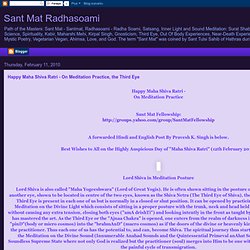
He is often shown sitting in the posture of a meditating Yogi with another eye, shown to be located in centre of the two eyes, known as the Shiva Netra (The Third Eye of Shiva), the Third Eye, etc. In fact, this Third Eye is present in each one of us but is normally in a closed or shut position. It can be opened by practicing "DrishTi Yoga" or the Meditation on the Divine Light which consists of sitting in a proper posture with the trunk, neck and head held in a vertical straight line without causing any extra tension, closing both eyes ("amA drishTi") and looking intently in the front as taught by an adept Guru who himself has mastered the art. . - English Translation by Pravesh K. 1. 2. 3. 4.
The Kama Sutra of Vatsyayana's "The Sixty-Four Arts of the Kama Shastra" on Lists of Bests. Linga Puran. At the time, when this incident of mystical Shiva linga had occurred and after which Lord Brahmaand Vishnu had stopped quarelling, Lord Shiva appeared before them and said--- "I am very pleased with both of you, Both of - " O Vishnu! You are the creator, Lord Shiva. This made Lord Shiva extremely pleased and he the preserver as well as the destroyer of this world. I am the supreme you, though having distinct identities have actually manifested from my body-Brahma from my left side and Vishnu from my right. " almighty and distinct from all three of you-Brahma, Vishnu and Mahesh.Lord Vishnu expressed his undiluted devotion towards Lord Shiva. LiPu. This is the Fifth Purana.

Preaching about the greatness of Lord Shiva and propagation of Ling-puja (worship of Shiva-Ling) are the main objectives of this Purana. This Purana has two parts. First Part : Description of the creation. Origin of Ling and its worship. Yagya by Daksha. Second Part : Greatness of Lord Vishnu, Lord Brahma becomes the creator,Incarnations Of Shiva During Various Dwapar Yugas ,Dadhichi Subjugates The Sages and Shilad's Impossible Demand. Lp-1. Once, sage, Narad arrived at Naimisharanya where he found many sages engaged in austerities.

All the sages were delighted to see him. They eulogized him in reverence and offered him seat. Sage Narad narrated some amazing tales describing about the greatness of Linga Puran. This made the sages even more curious about Linga Puran. Right then, Sutji also arrived there and the sages requested him to narrate the tales of Linga Puran. After making salutations to lord Brahma, Vishnu, Mahesh and Sage Krishna Dwaipayan, Sutji said--- Sound is the medium through which the almighty Brahma manifests himself.
Kaam shastra. Maharshi Vatsayan says that married women, wife of the brother, sister of the mother, old maid and elder sister are all the teachers to teach young girls in Kamasutra.

In Mahabharat, the king of Virat had appointed Vrihannala (Arjun in eunuch guise) to teach his daughter Uttara in the arts related to Kamasutra. But now a day feeling of motherhood is diminishing in the society. Bearing top priority of so called modern women. Sexual desires and their fulfillment come first for such so called modern women. How much will they be concerned about the future of their daughters, no one can say that.
Index. Pakam. Practical aspect of Kamasutra has two divisions – One deals with Tantra and second deals with the Asanas or postures.

Thus, it is the main part of Kamasutra. Union of male and female forced has been a continuing process since the beginning of the creation. And it will continue as long as life exists on the earth. As there are innumerable forms of life, there are innumerable ways through which female and male forces can unite. Kamashastra. Well before the exposition of Kamasutra, a certain sage called Babhravpanchal had compiled a treatise, the Kama Shastra.
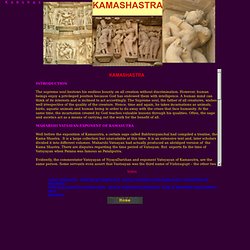
It is a large collection but unavailable at this time. It is an extensive text and, later scholars divided it into different volumes. Kaam shastra. Any religious scripture has four goals – achievement of Dharma (religion), Arth (Wealth) and Kama (pleasures) and Moksha (salvation) through them.
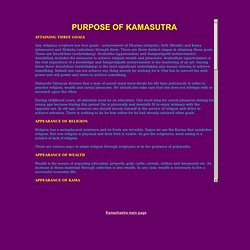
There are three distinct stages in attaining these goals. These are Anushthan (undertaking). Avabodha (appreciation) and Sampratipatti (achievement). Anushthan includes the measures to achieve religion wealth and pleasures. Norse Gods, Goddesses, Giants, Dwarves & Wights. This is more than just a list of the players, it's also a lexicon ("ordbok") of terminology one encounters while reading about Norse mythology and runelore.
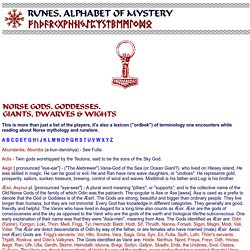
Abundantia, Abundia (a-bun-daníshya) - See Fulla. Aclis - Twin gods worshipped by the Teutons, said to be the sons of the Sky God. Aegir [ pronounced "eye-ear"] - ("The Alebrewer") Vana-God of the Sea (or Ocean Giant?) , who lived on Hlesey island. Hàvamàl. Nidstang - A Runic Cursing Pole. "In the Viking age the most spectacular way of cursing an enemy was by the Niding Pole (the Nithstong or Scorn-Post).

They were poles about nine feet (2.75 meters) long upon which insults and curses were carved in runes. Rune Stadhagaldr (Runic Yoga) Seidr & Norse Shamanism-Trance Travel & Magic. There is a growing interest in recreating the ancient oracular or 'shamanistic' techniques that are commonly referred to by Asatruar as seithr and spae-craft.
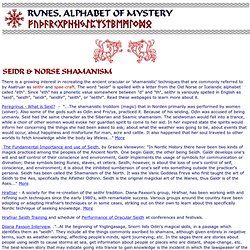
The word "seidr" is spelled with a letter from the Old Norse or Icelandic alphabet called "eth". Since "eth" has a phonetic value somewhere between "d" and "th", seithr is variously spelled in English as "seid", "seidh", "seidr", "seidhr", "seith", or "seithr". Read these webpages to learn more about it. Peregrinus - What is Seid? Google Translate. Sushumna, Ida and Pingala: Nadis of the subtle body. In addition to the seven chakras of the subtle body, the Tantras have described a network of subtle channels known as nadis through which the life force (prana) circulate.
Nadi means "stream". According to the tantric treatise Shiva Samhita, there are fourteen principal nadis. Who was the Buddha? The Buddhist laymen's practice. The Sense Organs And Their Role In Our Suffering And Delusion. By Jayaram V.
Nadis. Healing. Meditation. Yoga. Tantra Kundalini. Chakra.